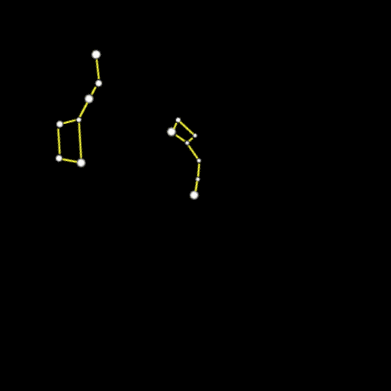(Thanks to everyone who voted in the sidebar for this month's constellation...at one point I thought Leo might win, but there was a last vote in on Ursa Minor, so Ursa Minor it is! :-) )
What does Ursa Minor look like?
Where Ursa Major is the Larger Bear, Ursa Minor is the 'Smaller Bear' or Little Bear (also called the Little Dipper) nearby its brother.
The shape of it is similar to the 'Big Dipper' (saucepan) part of Ursa Major - a pan shape of four stars marking the corners with a long handle marked by a further four stars. It has the distinction of being the most northern constellation, the tip of its tail being marked by Polaris (the North Star or Pole Star) the star that travellers have for centuries used to find their way north. So the little bear swings round the North Star by its tail:
From Synaptic Systems, we can see how the two bears rotate around the North Star :
Where can we find Ursa Minor?
As we saw when we were looking at the Plough of Ursa Major, we can find the North Star by following the two pointer stars (Dubhe and Merak) of the bowl of the saucepan: |
| (image: Royal Museums Greenwich) |
 |
(Image: All the sky- go to website for a hover-over image
showing the constellations with and without the labelling)
|
On the other side of the Little Dipper is Cassiopeia, the W:
 |
| (image Synaptic Systems) |
These three constellations all rotate around the North Star, and can be seen in the northern sky all the year around. They are what's called 'circumpolar'. In fact, there are a group of stars going around the North Star - Ursa Major, Ursa Minor, Cassiopeia, Draco (a dragon whose tail actually sits between the two bears) and Cepheus (looks like a house, but is actually a king), Camelopardalis (guess what this is...ok that was a trick question. It's not a camel as one might think, but a giraffe :-) ) and the Lynx :
 |
| (image: Starlight-nights) |
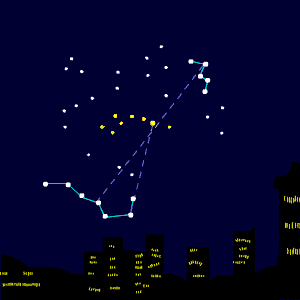 |
| (image: Wikipedia) |
 |
| (image: Miguel Claro from Earth Science Picture of the Day (epod)) |
You can see how this trail is made from this image from UCIrvine, which shows an incomplete rotation:
So, now we know exactly where it is - the centre of the current northern sky (due to precession, the Earth's wobble, mentioned previously, the star above the North Pole will not always be Polaris but will change over time...more in the Polaris section below) - let's find out what stars make up the asterism...
What are the main stars of Ursa Minor?
As said above, there are 8 main stars in the constellation of Ursa Minor, four in the body/head (Kochab, Pherkad, Ahfa al Farkadain [ζ UMi], and Alasco/Anwar al Farkadain [η UMi]) and four in the tail (Polaris, Yildun, Urodelus [ε UMi] Pherkad Major (more normally called Lamda Ursa Minor) [λ UMi]: |
(star labels in blue added to original image:
William Tyler Olcott from Constellation of Words) |
I'm going to also throw in this image from Night Sky (Girls), because it shows a lot of information on it:
Polaris
In line with its important position in the sky, having been used to guide travellers for millenia, Polaris (Alpha (α) Ursae Minoris [α UMi]) has an abundance of alternate names (Pole Star, Lodestar (guiding star, derived from the Old Norse leiðarstjarna), Alruccabah, Cynosura (from Greek κυνόσουρα/kunosoura, meaning 'dog's tail', as the little bear was once thought of as a dog), Phoenice, Tramontana (Tramontane is a northern wind), Angel Stern, Navigatoria, Stella Maris (sea star), Star of Arcady, Yilduz, Mismar (needle or nail), Polyarnaya, Dhruva).Polaris is the 'diamond' of a ring of (not visible with the naked eye) stars called the Engagement Ring:
 |
| (original image: Polar Project) |
 |
| (image of Alpha Ursae Minoris system: Constellation Guide) |
But it's the supergiant that most interests astronomers. Today, the star is 2.5 times brighter when Claudius Ptolemy (c. AD 90 – c. 168) recorded it. It is about 432/4 light years away, and though it is only 4.5-6 times the mass of our sun, its radius is 45 times and its luminosity is 45000 times!! Being the closest Cepheid variable to us, it is important to astronomers, because its properties are used to determine the distance of other cepheid variables, and the systems they're in.
In fact, despite many recent studies agreeing with the Hipparcus spacecraft distance measurements, using stellar *parallax, some doubt has been thrown on how far Polaris is by using high definition spectral analysis. Some have even estimated the star as a hundred light years nearer than by the parallax methods at 323 ly.
[*parallax: in the same way as holding your finger in front of your face and closing first one eye, then the other to look at something...and measuring how much it appears to move against the background, the distance of the object can be worked out using triganometry.]
This image, from the Polar Project, shows how the true north is moving towards Polaris, marking where it was in 1950 and 2000 (it will be the closest to Polaris about 2110):
After that, because of the way the Earth wobbles on its 'axis' (precession) it will slowly (thousands of years) make it's way toward Alrai of Cepheus, and it'll be nearly 26000 years before it'll be that close again:
Polaris and the North Pole
We have used Polaris to mark the North Pole for some time now but, although it's close, it's not actually spot on 'true north'. In fact, in 2014 it's still almost 3/4 a degree away!This image, from the Polar Project, shows how the true north is moving towards Polaris, marking where it was in 1950 and 2000 (it will be the closest to Polaris about 2110):
After that, because of the way the Earth wobbles on its 'axis' (precession) it will slowly (thousands of years) make it's way toward Alrai of Cepheus, and it'll be nearly 26000 years before it'll be that close again:
 |
| (image: Kerry V. Magruder, created from Voyager II software) |
Kochab
Kochab (Beta (β) Ursa Minoris, also called Kokab or Kochah) appears to be the second brightest star in the constellation (but only just) after Polaris, but since it's a quarter to a third of the distance away, its actual luminosity is much less. Like Dubhe and Merak, the pointer stars of the Big Dipper, Kochab, along with the gamma star of Ursa Minor, Pherkad, are two stars you can see without a telescope or binoculars that mark the front of the 'saucepan' bowl, but these two are often called the Guardians of the Pole or the Indestructables
Kochab is an orange giant that has finished burning hydrogen, the outer layer expanded off to a great distance, making it appear very much more luminous. Some around the internet think it might already have gone supernova (exploded), since it's certainly close to that stage, but that we might not see it for over a hundred years, the time it would take the light to reach us. I didn't find any official information about that though, so it is probably just conjecture.
It also apparently has a planet (I guess I should call it an exoplanet, since it's not around our sun) of six times the mass of Jupiter.
It also apparently has a planet (I guess I should call it an exoplanet, since it's not around our sun) of six times the mass of Jupiter.
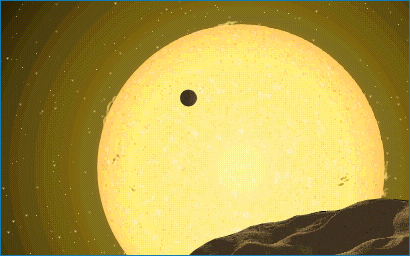 |
| (image: esky) |
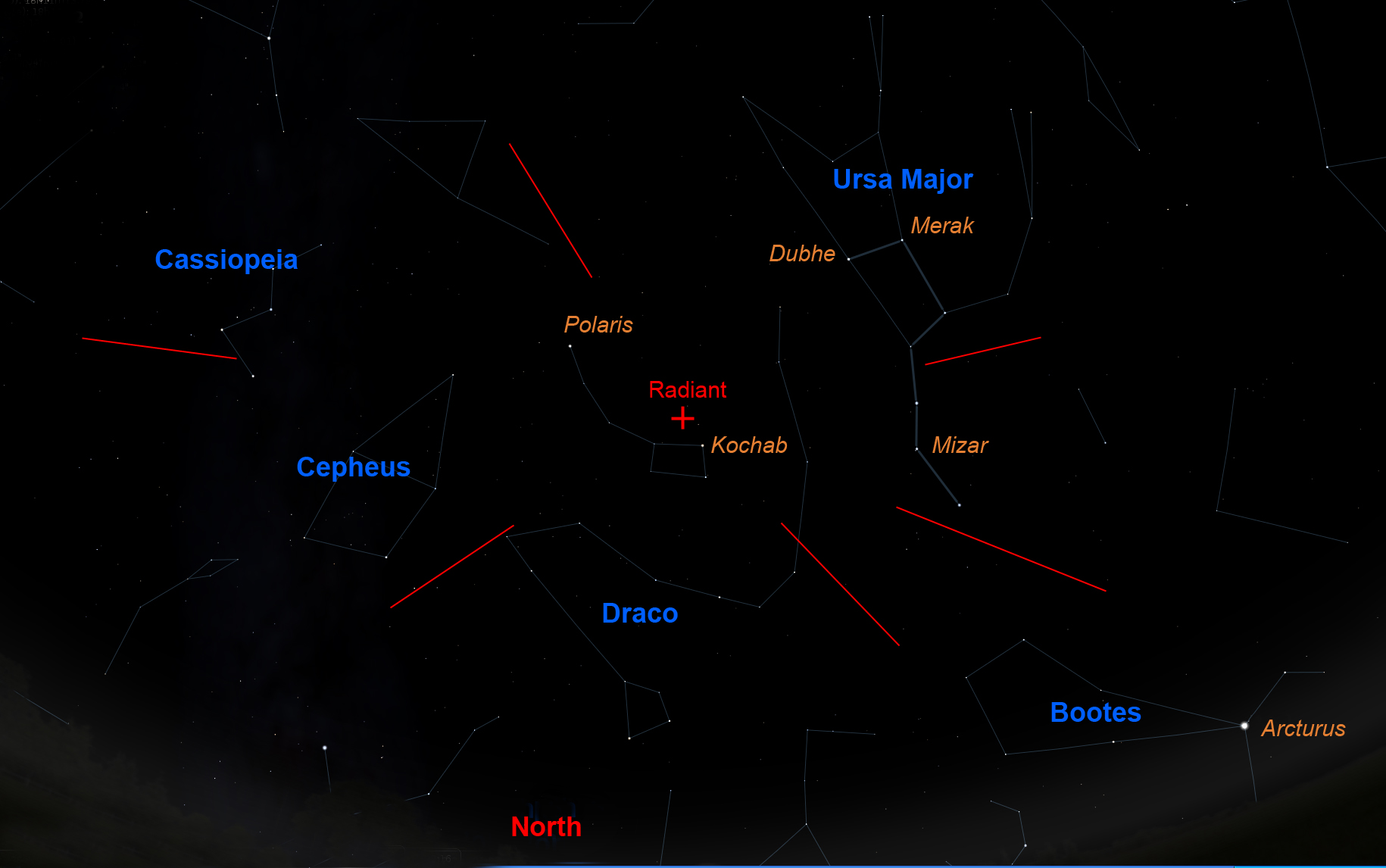 |
| (image: Jodrell Bank Centre for Astrophysics) |
This meteor shower lasts about 8 or 9 days, from about 17th December through Christmas and Boxing Day, and may be the result of the Earth passing through debris left behind by comet Tuttle (also known as 8P/Tuttle or Tuttle's comet, with the meteors peaking around 22nd December (most of the meteors will be seen within 12 hours of the peak).
Pherkad (Pherkad Major)
Pherkad (short for 'the dim one of the two calves'; or gamma Ursa Minoris) is another Be star, spinning so fast (about 180 km per second) that it has flung off a disc of gas and dust around its equator. It is a hot (nearly 8300 Kelvin). white supergiant, nearly 490 light years away, and can be easily seen with the naked eye. It is also a Delta Scuti Variable (or 'dwarf cepheid'), which pulses brighter and dimmer due to radial and non-radial surface pulses, about once every about 6 hours, and is used to compare the distance of other similar stars (it is used as what's called a standard candle)
Pherkad plays the part of the star around which orbits a fictional planetary system, in the Nintendo Gamecube video game 'Baten Kaitos Origins'. This might actually refer to the exoplanets of 11 UMi b or Pherkad Minor, which is close to Pherkad Major in the sky
Yildun
Yildun (Delta (δ ) Ursae Minoris), the third star along the 'handle' of the Little Dipper, is the white star ringed in the top right corner of this imageYildun is the closest officially named star to the Polaris, the North Star, and has the distinction of being one of the few stars not given a Greek or Latin name. The name is Turkish for 'star'. Yildun may not be visible in a city, where street lights might prevent viewing many of the less bright stars, but can be viewed all the way down to nearly the equator (3 degrees North)! It's about 2.5 times the diameter of the Sun but spins 87 times faster (147km per second) and is 47 times more luminous.
What are the deep sky objects of Ursa Minor?
Unfortunately, I was unable to find any other notable deep-space objects in Ursa Minor than the Ursa Minor Dwarf galaxy, so a I'll give you what I could find on this.You won't be able to see the Ursa Minor Dwarf Galaxy without help from a darned good telescope. I couldn't find where it was on the internet, so I used the Stellarium program to locate it, so we could at least know where it is.
As it happened, it wasn't actually marked on the Stellarium map, so I had to zoom in and find the nearest star to mark it:
The UMi Galaxy, as it is sometimes called (also named PGC 54074, UGC 9749 in catalogues), is a small satellite galaxy of our own galaxy, orbiting the Milky Way, discovered in 1954 by A.G. Wilson at the Lowell Observatory . It is around 200,000 light years from us between the edge of the disc of the Milky Way and the edge of the dark matter halo of the Milky way:
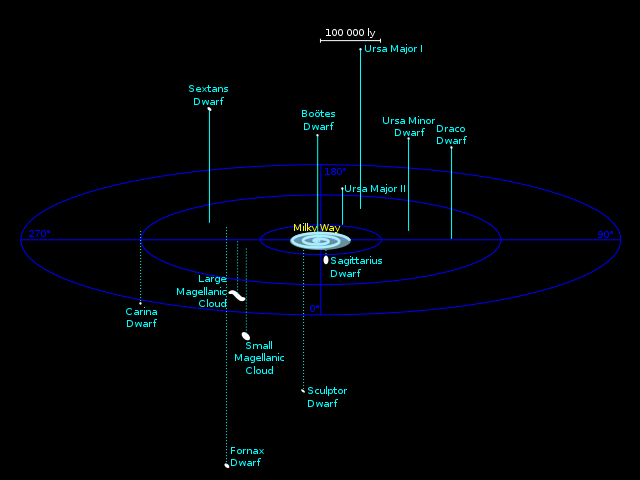 |
| (image: Wikipedia - interactive on the website) |
The stars of the elliptical galaxy (kind of lens shaped) are all about 11 billion years old and held together by gravity. There's no star-formation any more.
 |
| (image: Canada, France, Hawaii (CFH) Telescope) |
For a little further interest, in 2009/10, whilst studying the Ursa Minor Dwarf Galaxy, Ricardo Muñoz, an astronomer at the University of Chile, discovered the dimmest globular cluster (a spherical group of old stars held together by gravity) so far to be discovered orbiting our Milky Way Galaxy, and called it Muñoz 1. He spotted a dot on an image that turned out to be possibly 100,000 light years in front of the dwarf galaxy, and moving independently from it:
Here's a close up of Muñoz 1:
 |
| (Image : Geha/Muñoz/CFHT) |
If you want to know about any other deep space objects in Ursa Minor, I'd recommend downloading Stellarium, which can be set to show galaxies and nebulae. Turned up to the fullest, this is what it shows for the Ursa Minor area:
The great thing about Stellarium is that you can set it for any time or location, so you can see what the sky will look like tonight, or in 20 years!
How far away are the stars of Ursa Minor (Little Dipper)?
Previous constellation: Taurus
Next constellation: Leo
(There's a voting form in the sidebar)
(There's a voting form in the sidebar)

